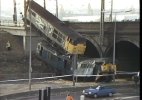devon_belle
Member
These days, in most cases, a collision with bufferstops in a siding or platform would be considered an incident. Historically, were bufferstops used differently? I.e. would goods trains have backed right up onto the bufferstops, and would they be used to stop wagons during loose shunting? I've definitely seen photos of carriages and rakes of wagons right up against the buffers in sidings, so I am wondering if this was just (frequent) sloppy shunting or common practice?

